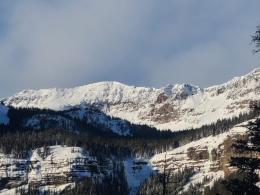Good morning. This is Dave Zinn with the Gallatin National Forest Avalanche Forecast on Wednesday, February 21st at 7:00 a.m. Today’s forecast is sponsored by Gallatin County Sheriff Search and Rescue and Highline Partners. This forecast does not apply to operating ski areas.
Mountain temperatures are in the teens to low 20s F this morning, with 10-20 mph winds from the west to southwest. The mountains south of Big Sky through Island Park and Cooke City received 1-3” of new snow. Today, temperatures will be in the upper 20s to mid-30s F with 5-15 mph winds from the west to southwest. The southern portions of the advisory area may receive a trace of snow in the next 24 hours.
All Regions
Stepping into backcountry avalanche terrain (slopes steeper than 30 degrees) anywhere in the advisory area is like stepping onto the casino floor with the odds stacked against you. You might win a hand or two, but you’ll likely lose in the long run. Persistent weak layers buried 2-4 feet deep under a slab of cohesive snow are failing and propagating widely. Yesterday, stronger winds drifting snow into thicker slabs on wind-loaded slopes, and 1-3” of new snow in the southern portions of the advisory area are a pair of aces in the dealer’s hand. Limited wet snow instability will increase as the day warms, especially in the Bridger Range.
Large avalanches and red flags indicating instability continue with alarming regularity. Yesterday, a group south of Cooke City triggered a collapse that rippled out over 100 feet (observation). Over the holiday weekend, groups reported natural avalanches on Bridger Peak and south of Saddle Peak. On Sunday, Doug and Alex triggered an avalanche from a long distance away near Buck Ridge while going to investigate a pair of large avalanches triggered on Saturday (video and observation, Saturday’s avalanches). In Cooke City, I watched shooting cracks race from our feet, propagating across an avalanche starting zone that was within a few degrees steepness of releasing and sliding (video and observation). Two large avalanches broke naturally in the Mount Bole basin in Hyalite Canyon (Photos and details). An avalanche failed and ran through thick trees in Tepee Basin (photo and details). A rider was partially buried in the Taylor Fork after getting caught, carried, and deploying an airbag (details). A number of snowmobilers triggered avalanches in Cooke City, including a large slide on the north side of Scotch Bonnet that broke 400 feet wide and up to 6 feet deep (photos, details, video). This is a small selection of the action detailed on our avalanche and weather log.
Recreating in terrain less than 30 degrees steepness and minimizing your exposure to runout zones will keep you safe from avalanches (use the 20-30 Rule). From the field, Ian and I recently advised against convincing yourself that conditions are safer based on limited signs of stability seen in snowpits or the absence of red flags (Cooke video, Bacon Rind video). Do not try to outsmart an unstable snowpack. The house will win sooner or later.
The danger is rated CONSIDERABLE.
If you venture out, please fill an observation form. It does not need to be technical. Did you see any avalanches? How much snow is on the ground? Was the wind moving snow? Simple observations are incredibly valuable. You can also contact us via email (mtavalanche@gmail.com), phone (406-587-6984), or Instagram (#gnfacobs).
Upcoming Avalanche Education and Events
Our education calendar is full of awareness lectures and field courses. Check it out: Events and Education Calendar.
Every weekend in Cooke City: Friday at The Antlers at 7 p.m., Free Avalanche Awareness and Current Conditions talk, and Saturday from 10 a.m.-2 p.m. at Round Lake Warming Hut, Free Rescue Practice.
Loss in the Outdoors is a support group for those affected by loss and grief related to outdoor pursuits. Check out the link for more information.
A recent article, As radio use spreads in backcountry, so do community channels, describes the benefits of communicating amongst groups in heavily trafficked areas.


